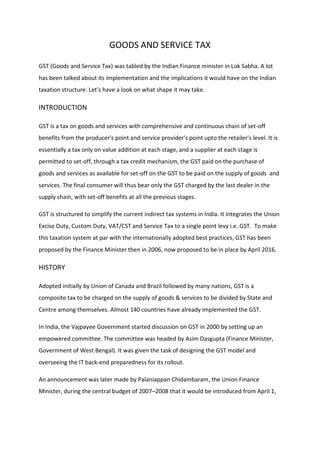GST (Goods and Services Tax) is a comprehensive indirect tax that will replace existing indirect taxes and integrate taxes at the Central and State levels. It is proposed to be implemented in India in 2016. GST is based on the idea of providing set-off benefits from taxes paid at earlier stages of production, allowing only the value addition at each stage to be taxed. This will eliminate cascading of taxes and reduce the overall tax burden. The key benefits of GST include reducing business compliance costs, boosting export competitiveness, and lowering prices for consumers.







![It is expected that GST would be levied on the transaction value i.e. actual price paid or
payable for supply of goods and services. The discussion paper and the Constitution
Amendment bill 2014 indicate that the empowered committee has decided to adopt the
following rate structure for taxing goods and services:
Exempted goods: The short list under the State VAT law-0%
Special rate: Precious metals- could be 1 %
Concessional rate: Necessities and goods of basic importance [the concept of
declared goods would no longer be relevant] -could be 10%
Standard rate: For all other goods- could be 20% [Maybe more is the indication]
States may be able to fix the SGCT based on a band say 9-11%. [1-2 %]
The recommended uniform State GST threshold of INR 25 Lakhs for both goods and services
and composition scheme for those between Rs. 25 Lakhs to 75 Lakhs is being discussed.
A 1% tax would accrue to the originating States for a period of 2 years unless extended by
the GST council.
GST Council may change any of the above mentioned rates as further discussions and
meetings of union ministers and empowered committee are held.
CREDIT SCHEME
GST would be levied on supply of goods and services and the supplier would be allowed
credit for the GST paid on purchases. The credit would be seamless except that the credit of
CGST paid would not be allowed for set-off against SGST payable and vice versa.
The objective of seamless credit would be met except for those below the threshold limit,
those under special composition schemes and the products which are exempted. Presently
in the central as well as the state tax laws a number of restrictions exist on eligibility of
goods and services used for business. It is hoped that these anomalies would be taken care
off in the draft law which is expected to be in place by June 2015.
Introduction of the Constitution Amendment Bill in the Lok Sabha in December 2014, has
rekindled some hope. Though the government continues to stay non-committal on the date
of introduction of GST, it is encouraging a go live in April, 2016.](https://image.slidesharecdn.com/gst-150924174557-lva1-app6892/85/GST-8-320.jpg)
